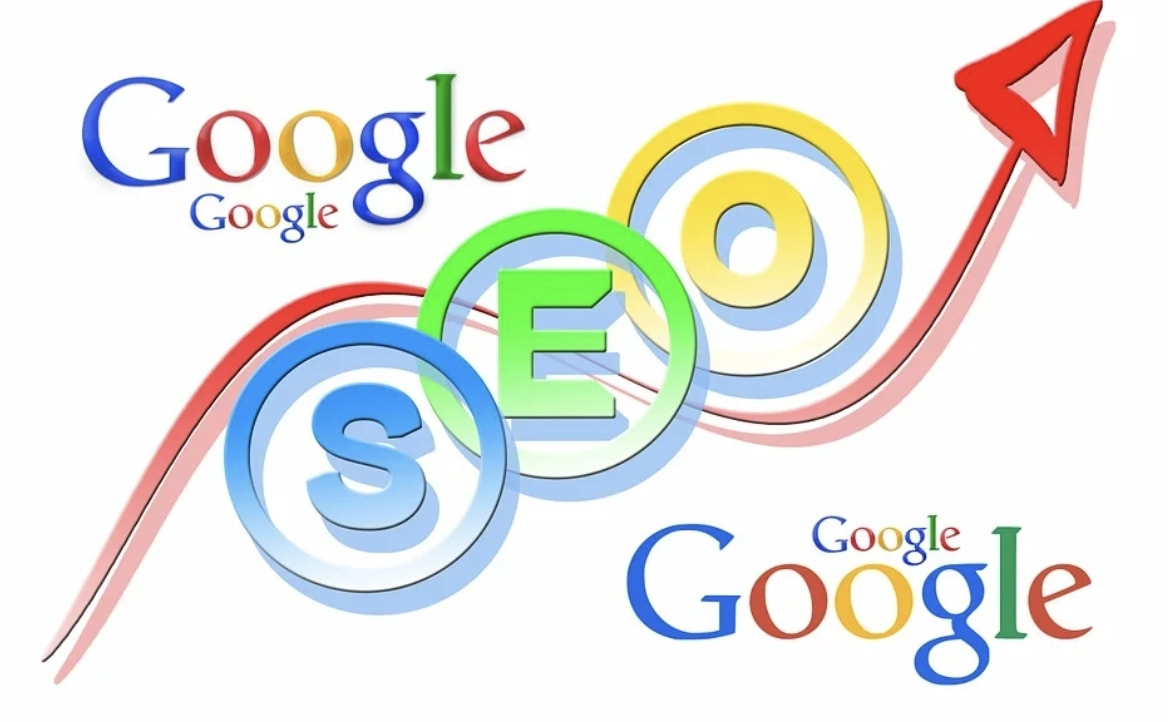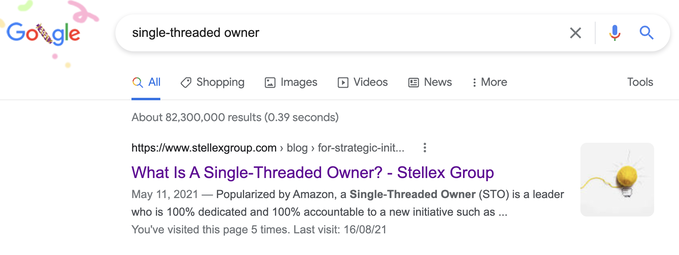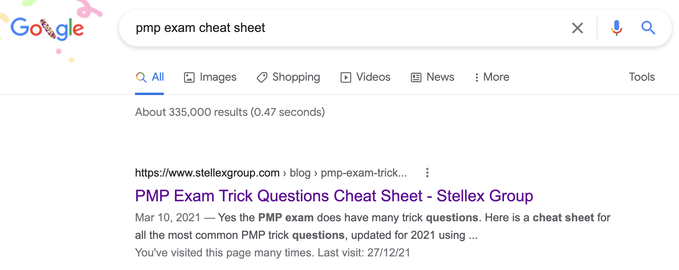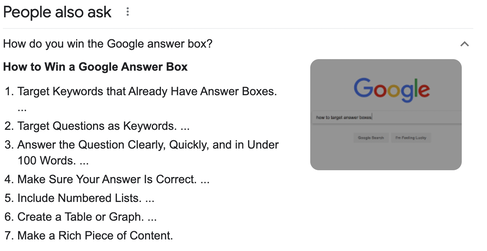|
Consultants will tell you that it takes time for a new website to rank highly with Google SEO. Yet I was able to get some of my new website's pages to rank #1 within a few weeks, without any paid ads. I have done program management, business development and marketing for 20 years, but I'm no SEO expert. But since I had some success just experimenting with SEO part-time, I thought to share my findings. 1. USEFUL CONTENT THAT ANSWERS A QUESTION Think about websites that you yourself have visited, especially those you visit regularly - what is it that brings you back? Probably you go to a website to read useful, practical information that answers your question. Some call this "thought leadership", but "thought leadership" implies you have to be somehow producing visionary content and manifestos, and actually, most readers don't want that. They just want practical information that answers their questions. One page I have that ranks consistently #1 is an answer to the question What Is a Single-Threaded Owner? I found that there were not a lot of good explanations about this industry term, so I wrote an article explaining it. After some initial discovery my article ranked #8. Then I had to find ways of updating it to push it to #1. 2. ANSWER THE QUESTION BETTER THAN OTHER WEBSITES I skimmed the other 7 articles that ranked higher than mine and found aspects that they were addressing better than me. So I made sure to update my article to be more comprehensive. Google is ranking pages based on engagement, authority, and ability to answer a question comprehensively. 3. FOLLOW SEO FORMATTING BASICS Content is most important as you can see from step 1 and 2, but Google's algorithm does still look at the format of the web page for its prioritization as well. So once you're in the top 5, some basic page formatting helps to rise to #1. I followed the guidelines from Apollo Digital, though there are many similar checklists online: First, choose the keyword that you want to optimize for. Read more: How Do I Generate MQLs at a New Startup? 4. OPTIMIZE PAGE FORMAT FOR GOOGLE'S "ENGAGEMENT" CUES Google wants to see users spending time on the page and scrolling down, which it takes as a sign that readers are actually reading. So make sure what you write is engaging, especially the first few paragraphs. It also helps to write in short paragraphs of only 1 or 2 sentences, with a space in between each paragraph. Although this is contrary to traditional writing conventions, it does make it easier for readers with a short attentions span to follow and encourages them to scroll down and spend a few more seconds initially on your page. Also use bulleted lists to space out ideas, and color bars to highlight important thoughts. Google also wants to see users clicking forward from your page to another page, rather than clicking to go back (a further sign of engagement). So include useful links in your article for those that want to learn more, and put some of those links right upfront so that it gives users a chance to click right away to satisfy Google's criterion. 5. ESTABLISH AUTHORITY Google is looking to rank the most authoritative pages highest, so be sure to include some mention of your credentials in the page, e.g. state clearly the author's authoritative background and why you are uniquely positioned to write on the subject. In my case, I simply state in my article that I held roles for many years that resembled the Single-Threaded Owner. Google is also prioritizing comprehensive answers to questions, I have read that the post should be at least 2,000 words. 6. INCREASE PAGE AUTHORITY BY GETTING LINKS Since the early days of Google, it partly measures a web page's "authority" by considering how many other high-authority websites link to it and users are actually visiting the page via those referring links. Google has gotten really good, it seems, at ferreting out bogus links, so you can't just go linking to your web page frivolously. But some ways of getting real, useful links that I used included:
Another article I wrote that ranks #1 is a "cheat sheet" for the PMP project management certification exam. There is nothing special about this page. It is simply my collection of notes that I compiled while I was studying for the exam. I cleaned it up and shared it on a community forum where others who were studying found it useful. Google noticed that many folks were visiting it every day as a reference, so it quickly boosted the ranking. I'm particularly proud of this one since there are literally millions of pages related to the PMP exam online. You can see how many visits your article is getting via referring links in Google Analytics, and Moz's free domain analysis tool estimates the page authority number associated with your page. 7. ADD VIDEO Google is highly promoting video content. If relevant, try embedding a video in your article. I personally have been shy to do this, but I've seen many authors now posting youtube videos of themselves simply reading their article to the camera and embedding the video in the article. 8. OPTIMIZE FOR CORE WEB VITALS Google rolled out a major core search algorithm update, doubling down on its evaluation of your web site based on 3 "core web vitals":
Google is increasingly shaping their search algorithm to prioritize these 3 things that make for a better browsing experience on desktop and especially mobile. You can use GTMetrix or Google PageSpeed Insights to get a diagnostic of how your page is doing on these 3 criteria. I would not overreact to all the information and recommendations. But if you have a free hour, it could be worth taking the time to update a few common sense items. In my case, I removed images from my article except for 1 that was really useful, and I edited the image with a free tool to be smaller and low resolution. I see that a lot of authors such as authors on the popular Substack website are now publishing with little to no images at all, as images can slow down page loading (and Google de-prioritizes slow pages). I also ensured that my web page looked right on a mobile phone and a tablet, as Google prioritizes a mobile-first experience. For those who want to take their page optimization further, here are some more technical steps from Dr Jigsaw:
9. RICH SNIPPETS AND ANSWER BOXES Finally, you must have seen that Google is featuring rich snippets, content with specific structured metadata in JSON-LD that Google will show to help your post stand out. Example of a rich snippet that features an embedded image on the left and metadata at the bottom (star rating, number of reviews, run time): Google will prioritize pages with rich snippets, and they look more enticing, encouraging searchers to click on your link. Google is also ranking pages #1 if they can fit into Google answer boxes: To show up in an answer box, you need to ensure your article is directly and thoroughly answering a frequently searched question, and make sure the answer is the first paragraph. Use the structured metadata in the JSON-LD format that Google requires, so that Google prioritizes your post. I personally haven't done this for my own page yet, but have helped some clients with theirs. CONCLUSION By far, the most important steps are #1 and #2, creating useful, practical content that actually addresses questions that people have. And do it better than other websites already do. Add something new and useful to the internet! Writing useful content should be 95% of the time you spend. Optimizing your page format is very secondary.
There are a lot of people who will prioritize their time the other way around. Lousy content slapped together in a hurry, but lots of time trying to "hack" the google algorithm. That may have worked for spammers back in the 90s, but search is far too sophisticated to be hacked in 2022. There is a line of thought out there right now that the internet is saturated and it's hard to rank with Google without paying through the nose. Or that you have to wait a long time for pages to "mature" with SEO before Google will rank them. Hopefully my findings dispel these myths. Just follow the common sense rules of the algorithm, it's still very possible to rank organically (quickly). But you need to have something useful to say.
0 Comments
Your comment will be posted after it is approved.
Leave a Reply. |






